September 2006
Monthly Archive
18 months have gone by since I moved to Buenos Aires. It’s such a short time, particularly compared to those who have lived here for years or even their entire lives. Before leaving Miami I started this blog as a way of understanding the city and my life here. This entry marks the 200th post to this blog, more than 60,000 words.
I now know Buenos Aires better than I do any other city in the world. Walking the streets of Buenos Aires makes me feel alive. If I’m feeling depressed, a simple stroll around the city raises my spirits. Certainly, I am fortunate in my circumstances. If I had to struggle for survival here, then I may not be so in love with Buenos Aires. Then again, struggling anywhere is a heartache.
Each walk I take in this city brings an unexpected discovery, a fresh perspective. Go to an unfamiliar barrio or even one you think you know well, perhaps the very place you live. Choose a street, just start walking with no destination in mind. Don’t hurry, you’re going no where. The walk is the journey; walking Buenos Aires is your life at that very moment, nothing more.
Put other thoughts out of your mind. Forget annoyances from work and the things that must be done at home. Simply walk. Open your senses to the street, observe the life that is circling around you. Don’t hurry across the intersections. Wait on the corner for another change of the traffic signal. Look down the road, find the buildings that you may have missed with a quicker pace, each has something new to offer.
Just as important, pay attention to the people, those you normally might not notice: the man carrying a basket of bread from the bakery; the finely dressed old woman carefully leaving a building; the child on a balcony.
Listen to the sounds. Each street has its own voice, waiting for you.
In a comment to my last posting Robert mentioned the high rise towers being developed in Puerto Madero. For those of you who haven’t been down to Puerto Madero recently here is a photo of the construction that is taking place.
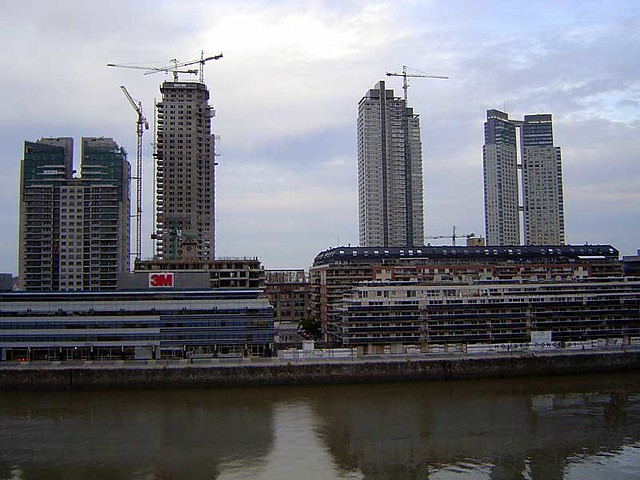
As far as I know, these towers are apartments and not office buildings. That’s a lot of expensive apartments. And I understand that more are in the planning stages. Honestly, I can’t figure out who is going to live in all those places.
My thoughts on Puerto Madero are know to regular readers of this site. Lately I’ve been doing a lot of work, spending most of my days, in one of those office buildings along the waterway.
What I didn’t previously realize is that some of those buildings have nice rooftop patios, nice spots for lunch. If you work in this area then it’s best to bring your own lunch since the area is filled with overpriced and not so good restaurants. I noticed this week that a Hooters has opened in Puerto Madero. That must be a sign that the economy is recovering. (Wasn’t there one in Village Recoleta a few years back?)
Anyway, the rooftop terrace makes for a nice view so I thought I would post a photo since few people get to see the area from that angle.
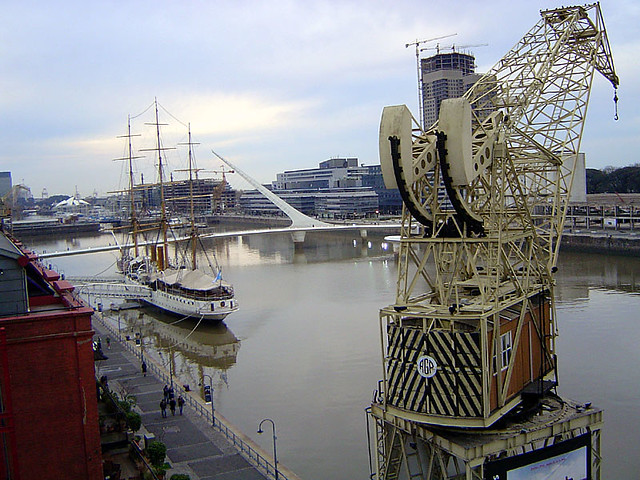
Saturday, 16 September, is the 30th anniversay of La Noche de los Lápiches (The Night of the Pencils), another sad but notable event from the most recent dictatorship in Argentina. Last year I wrote extensively about the march that took place on the 29th anniversary.
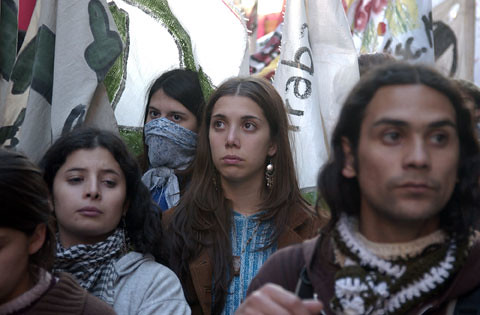
Since it’s the 30th anniversary there should be an equally large gathering. On the radio this morning I heard about a march planned for Friday evening at 6pm from Facultad to Plaza de Mayo. Today there is also a teachers strike at the University of Buenos Aires. I won’t be covering the march this year since I’ve made prior plans to hear a friend sing Celtic music.
Last year’s march was one of the largest that I saw in 2005. But last year there also was more tension between the piquetero groups and the police. Last year’s Night of the Pencils march was just one week after a very tense confrontation between piqueteros and police at the intersection of Av de Mayo and Av 9 de Julio. That march was originally planned to be an anti-Bush protest in anticipation of Bush’s visit to the summit in Mar del Plata. A large number of students were mixed in with the piquetero groups but the whole thing turned ugly when the police blocked Av de Mayo and pulled up the truck with the water cannon. It eventually ended in a few hardcore piqueteros throwing stones at the police while the other marchers walked away.
So, the following week on the 29th anniversary of the Night of the Pencils the turnout was enormous. The marchers made it to the plaza where I watched a number of young people (not piqueteros) paint graffiti on the monument in the middle of Plaza de Mayo.

The monument was quickly repainted by the next morning. Tonight’s march should be interesting but not as exciting as last year. I don’t know if there are any commemorative activities planned for Saturday, the actual anniversary. (People here seem to like to march on Fridays).
As disturbing as history
Ok, I’ve not been keeping up with the news the last few days, via Clarin I just learned about a controversial entry in the Spanish version of Wikipedia about la Noche de los Lápiches.
The entry has been updated but see this link for an older version of the entry on La Noche de los Lápiches that claims la noche de los lápices was invented by terrorist organizations and that the seven youths who were kidnapped by the government on 16 September 1976 were actually terrorists. What is disturbing is that this viewpoint that the military government of 1976-1983 was in a struggle against terrorism is still accepted among certain parts of Argentine society. Admittedly, Argentina during the 1960s-1970s is a very complicated history – one that everyone needs to reflect upon.
Across Av Caseros from the old prison is a very nice park, Parque Ameghino. I’m very fond of the parks and plazas scattered through Buenos Aires, so I thought I would check this one out.
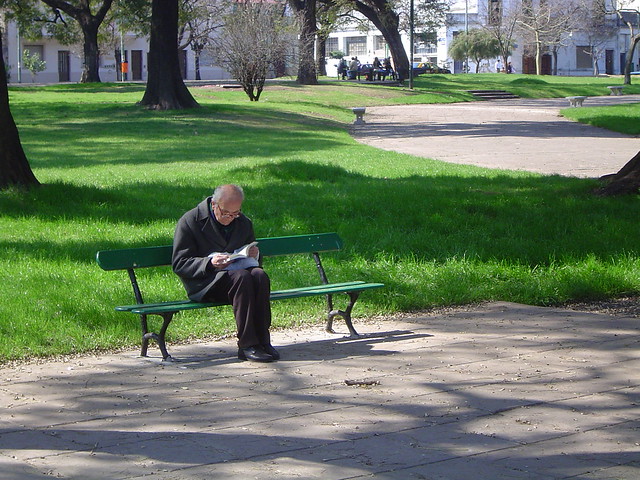
Just after entering the park I saw a small sign with a brief history of the park. The park was originally the Cemeterio del Sur, which dates back to 1867. The next year 1,400 victims of the cholera epidemic were buried there. Just a few years later during the 1871 Yellow Fever epidemic more than 14,000 people who died from the disease were buried in the cemetery.
A monument to the victims of Yellow Fever is at the center of the park. The monument has a nicely detailed scene.
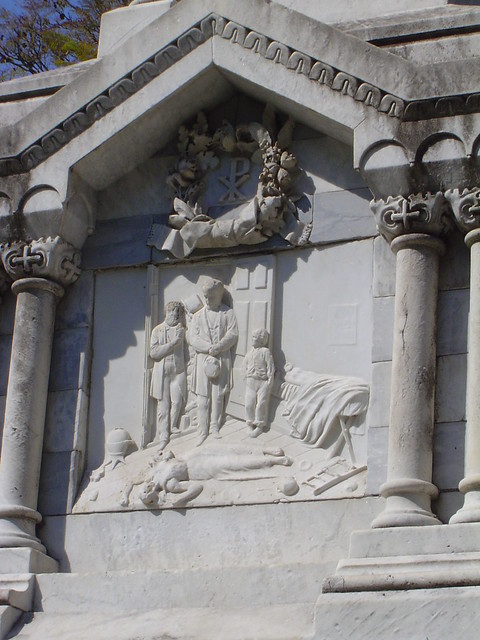
On his excellent blog dedicated to Parque Patricios Gabriel has much more information (in Spanish) about Parque Ameghino, the monument, and the history of the cemetery.
When I was at the park I kept wondering what happened to those that were buried there. Gabriel provides one clue and photo at the end of his posting that indicates the location of a small rise in the land in the park, which according to a local historian, is the spot of a common grave.
At some point I’m wanting to do more research into the Yellow Fever epidemic of 1871. A few years ago I read a fascinating book Yellow Fever and the South . That’s the American South not South America. But I think an interesting book to research and write someday is an examination and comparison of 19th century Yellow Fever epidemics in both North and South America. There are surely some fascinating stories to uncover. Well, guess I just add that to my long list of things to do!
. That’s the American South not South America. But I think an interesting book to research and write someday is an examination and comparison of 19th century Yellow Fever epidemics in both North and South America. There are surely some fascinating stories to uncover. Well, guess I just add that to my long list of things to do!
Continuing my walk along Av Caseros beyond the hospital zone I saw on the next block an old building with a turret. At first I couldn’t imagine it’s purpose, thinking that the turret must have simply been decorative. That would have made for a rather odd touch but then there are a lot of unusual buildings in Buenos Aires.
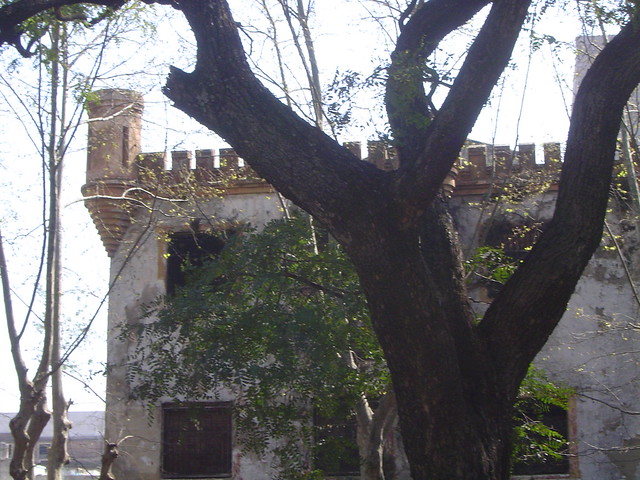
Then I remembered a recent conversation with Robert who mentioned the old prison in Parque Patricios. From half a block away the prison wasn’t what I was expecting. Perhaps it was the seemingly innocuous nature of the place but the Old Jail in St. Augustine, Florida came to my mind. Yet, this was no tourist attraction. As I rounded the corner I saw the full extent of the abandoned prison and the more recent two towers that contained the cell blocks at the rear.
Robert has a couple of posts about the old prison: one about a documentary of interviews with political prisoners who were housed in the prison. Another about a recent art project about faces that appear in the windows of the prison. I remember Robert telling me about this project and reading his post on it last month. So, when I was there on Saturday I went down the side street and looked for the faces. Honestly, I couldn’t quite see anything that looked like faces. I did see the windows and the patterns but the shapes didn’t quite appear to me. But after reading Robert’s post again, perhaps I wasn’t standing at the appropriate angle. So, I’m going back for another look.
Besides, Gabriel’s blog dedicated to Parque Patricios reveals that the barrio – like so many areas of Buenos Aires – offers much more to explore.
There’s still more to come from my walk last Saturday, stay tuned.
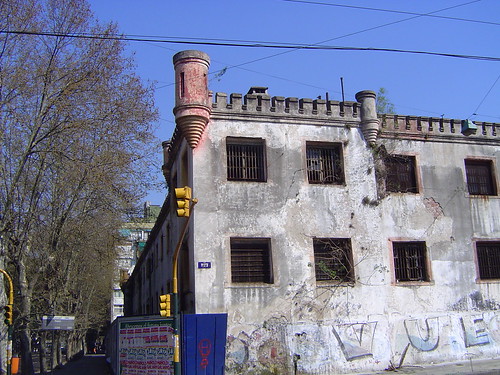
Saturday morning I wanted to explore an area of Buenos Aires that I’ve not seen on foot, an area that I’ve only passed through on the bus or the backseat of a taxi. I left San Telmo and walked west, making my way through the park in front of Constitución station then heading down towards Av Caseros. My destination was simply to wander along Caseros seeing what I encountered.
Actually, I now live on Av Caseros but on the east side of Av 9 de Julio where Caseros forms the border of San Telmo and Barracas. This part of Caseros is separated from its other half by the railroad tracks leading south from Constitución. On the west side of the tracks Caseros is the border of several barrios, separating Constitución from Barracas and leading onward to Parque Patricios. I’ve already explored the interior of Barracas but this time I wanted to walk as far as Parque Patricios before turning back towards San Telmo.
The weather Saturday morning was great for walking – sunny with a slight breeze, the type of day made for walking miles. Approaching Caseros on the other side of the train station, I came across a couple of young men, obviously Mormon missionaries, also walking about the city.
Parque España is another one of those city parks that has a bit of potential but this Saturday morning there were still a fair number of rumpled, smelly men hanging loosely around the benches. I ventured forward along Caseros.
Soon I came across the Centro Cultural del Sur, a venue that often has good musical performances featuring tango or folclore. Following the street I soon found myself amid a zone of hospitals.
I’ll continue my description of this walk in another posting. And I promise some photographs, too.
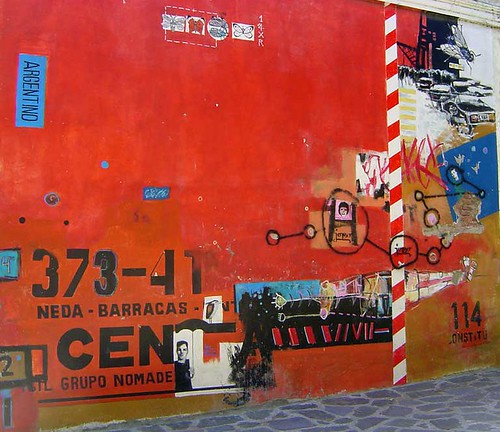
I’ve been away from the blog for a good part of this last month. The first thing that consumed my time was a big move to another apartment. Then just after we moved in, I got sick with a nasty cold that kept me caughing and in bed for a week. That was miserable.
The new place is only 3 blocks away from the old one but it was still a lot of effort to get things packed, moved, and then unpacked. Here’s a photo:
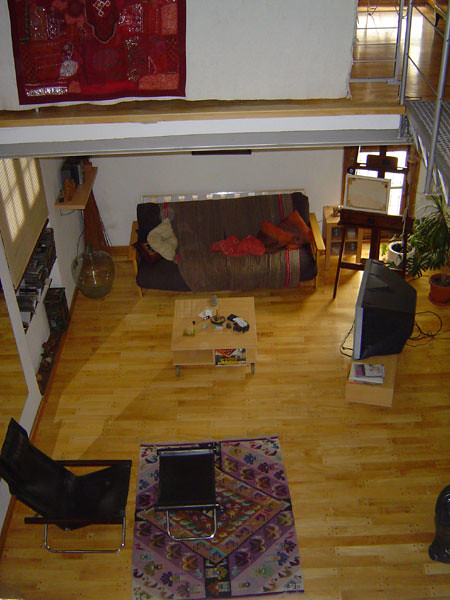
We like the new place. I guess it qualifies as a loft since it’s just one large space with an upper floor of open space connected by a bridge. There’s a lot of metallic steps going up to the 2nd floor and then a spiral metal stairway up to the roof, which has a nice large terrace. I’m looking forward to using that in the summer.
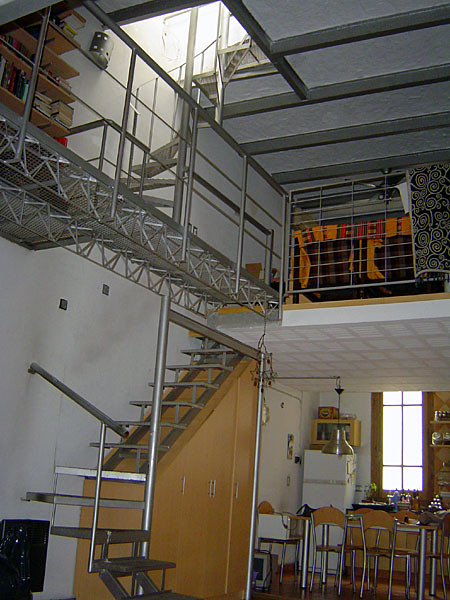
The metal makes for a cool industrial look but isn’t so comfortable on my bare feet. Anyway, that’s a good excuse to buy some nice house shoes.
One of the nicest thing about the apartment is that it’s very quiet. Located away from the front of the building, there’s no more roar of the buses careening down the street like in the other place.
While the interior of the apartment is fairly new, the building itself is quite old, early 20th century. I’ll have some photos of the exterior on another day.
The neighbors seem nice and interesting: a couple of folclore musicians, a photographer, and a dancer.










